Supramolecular Organization of Diaryliodonium Dicyanoargentates(I) Provided by Iodine(III)–Cyanide Halogen Bonding
Abstract
1. Introduction
2. Results and Discussion
2.1. Identification of Structure-Directing Noncovalent Interactions
2.2. Hirshfeld Surface Analysis
2.3. Theoretical Considerations
2.3.1. Electron Localization Function (ELF) Projections
2.3.2. ED/ESP Profiles
2.4. Dicyanoargetates(I) in Other σ-Hole Interactions
3. Materials and Methods
3.1. General Information
3.2. Synthesis and Characterization of Diaryliodonium Dicyanoargentates(I)
- Mesityl(phenyl)iodonium dicyanoargentate (1). Yield: 78% (23.9 mg), mp: 147–148 °C (dec.). HRESI+-MS (MeOH, m/z): 323.0288 ([M − Ag(CN)2]+, calcd 323.0291; HRESI−-MS (MeOH, m/z): 158.9114 ([M − C15H16I]−, calcd 158.9118. IR (KBr, selected bonds, cm−1): 2924 ν(C–H), 2123 ν(C≡N), 1563 (s) ν(Car–Car), 1443 δ(C–H), 743 δ(Car–H), 450 (s) ν(C–I). 1H NMR (500 MHz, Chloroform-d) δ 7.67 (m, 2H), 7.57 (m, 1H), 7.44 (m, 2H), 7.14 (s, 2H), 2.64 (s, 6H), 2.39 (s, 3H). 13C {1H} NMR (126 MHz, Chloroform-d) δ 146.72, 145.28, 142.44, 133.40, 132.85, 132.43, 131.16, 27.70, 21.63. The crystals suitable for XRD study were obtained by slow evaporation of CH2Cl2/Et2O solution at RT in air.
- Dimesityliodonium dicyanoargentate (2). Yield: 64% (32.4 mg), mp: 169–170 °C (dec.). HRESI+-MS (MeOH, m/z): 365.0767 ([M − Ag(CN)2]+, calcd 365.0761; HRESI−-MS (MeOH, m/z): 158.9115 ([M − C18H22I]−, calcd 158.9118. IR (KBr, selected bonds, cm−1): 2924 ν(C–H), 2139 ν(C≡N), 1589 (s) ν(Car–Car), 1456 δ(C–H), 756 δ(Car–H), 542 (s) ν(C–I). 1H NMR (400 MHz, Acetone-d6) δ 7.26 (s, 4H), 2.60 (s, 12H), 2.36 (s, 6H). 13C {1H} NMR (101 MHz, Acetone-d6) δ 144.87, 143.33, 142.63, 131.71, 118.74, 26.22, 20.84. Compound 2 was crystallized from methanol at RT in air.
- Mesityl(p-tolyl)iodonium dicyanoargentate (3). Yield: 84% (27.5 mg), mp: 146–147 °C (dec.). HRESI+-MS (MeOH, m/z): 337.0450 ([M − Ag(CN)2]+, calcd 337.0448); HRESI−-MS (MeOH, m/z): 158.9115 ([M − C16H18I]−, calcd 158.9118). IR (KBr, selected bonds, cm−1): 2924 ν(C–H), 2126 ν(C≡N), 1455 (s) ν(Car–Car), 1378 δ(C–H), 797 δ(Car–H), 479 (s) ν(C–I). 1H NMR (500 MHz, Chloroform-d) δ 7.57 (d, J = 8.4 Hz, 2H), 7.23 (d, J = 8.4 Hz, 2H), 7.12 (s, 2H), 2.64 (s, 6H), 2.39 (s, 3H), 2.38 (s, 3H). 13C {1H} NMR (126 MHz, Chloroform-d) δ 146.24, 144.85, 143.34, 142.04, 133.43, 133.40, 130.85, 122.08, 108.94, 27.42, 21.49, 21.34. Compound 3 was crystallized from methanol at RT in air.
3.3. X-Ray Structure Determinations
3.4. Computational Details
4. Conclusions
Supplementary Materials
Author Contributions
Funding
Institutional Review Board Statement
Informed Consent Statement
Data Availability Statement
Acknowledgments
Conflicts of Interest
References
- Desiraju, G.R.; Ho, P.S.; Kloo, L.; Legon, A.C.; Marquardt, R.; Metrangolo, P.; Politzer, P.; Resnati, G.; Rissanen, K. Definition of the Halogen Bond (IUPAC Recommendations 2013). Pure Appl. Chem. 2013, 85, 1711–1713. [Google Scholar] [CrossRef]
- Brinck, T.; Murray, J.S.; Politzer, P. Surface Electrostatic Potentials of Halogenated Methanes as Indicators of Directional Intermolecular Interactions. Int. J. Quantum Chem. 1992, 44, 57–64. [Google Scholar] [CrossRef]
- Mallada, B.; Gallardo, A.; Lamanec, M.; de la Torre, B.; Špirko, V.; Hobza, P.; Jelinek, P. Real-space Imaging of Anisotropic Charge of σ-hole by Means of Kelvin Probe Force Microscopy. Science 2021, 374, 863–867. [Google Scholar] [CrossRef]
- Tepper, R.; Schubert, U.S. Halogen Bonding in Solution: Anion Recognition, Templated Self-Assembly, and Organocatalysis. Angew. Chem. Int. Ed. 2018, 57, 6004–6016. [Google Scholar] [CrossRef]
- Benz, S.; Poblador-Bahamonde, A.I.; Low-Ders, N.; Matile, S. Catalysis with Pnictogen, Chalcogen, and Halogen Bonds. Angew. Chem. Int. Ed. 2018, 57, 5408–5412. [Google Scholar] [CrossRef]
- Nandy, A.; Sekar, G. Dibenziodolium Salts as Halogen Bond Donor Catalysts for the Reduction of Quinolines, One-Pot Reductive Amination, and Addition Reaction with Indoles. Eur. J. Org. Chem 2022, 2022, e202200982. [Google Scholar] [CrossRef]
- Auffinger, P.; Hays, F.A.; Westhof, E.; Ho, P.S. Halogen Bonds in Biological Molecules. Proc. Natl. Acad. Sci USA 2004, 101, 16789–16794. [Google Scholar] [CrossRef]
- Costa, P.J.; Nunes, R.; Vila-Viçosa, D. Halogen Bonding in Halocarbon-Protein Complexes and Computational Tools for Rational Drug Design. Expert Opin. Drug Discov. 2019, 14, 805–820. [Google Scholar] [CrossRef]
- Ho, P.S. Biomolecular Halogen Bonds. In Halogen Bonding I: Impact on Materials Chemistry and Life Sciences; Springer International Publishing: Cham, Switzerland, 2015; pp. 241–276. [Google Scholar] [CrossRef]
- Berger, G.; Frangville, P.; Meyer, F. Halogen Bonding for Molecular Recognition: New Developments in Materials and Biological Sciences. Chem. Comm. 2020, 56, 4970–4981. [Google Scholar] [CrossRef]
- Yan, D.; Evans, D.G. Molecular Crystalline Materials with Tunable Luminescent Properties: From Polymorphs to Multi-component Solids. Mater. Horiz. 2014, 1, 46–57. [Google Scholar] [CrossRef]
- Sivchik, V.V.; Solomatina, A.I.; Chen, Y.-T.; Karttunen, A.J.; Tunik, S.P.; Chou, P.-T.; Koshevoy, I.O. Halogen Bonding to Amplify Luminescence: A Case Study Using a Platinum Cyclometalated Complex. Angew. Chem. 2015, 54, 14057–14060. [Google Scholar] [CrossRef]
- Landenberger, K.B.; Bolton, O.; Matzger, A.J. Energetic–Energetic Cocrystals of Diacetone Diperoxide (DADP): Dramatic and Divergent Sensitivity Modifications via Cocrystallization. J. Am. Chem. Soc. 2015, 137, 5074–5079. [Google Scholar] [CrossRef]
- Bennion, J.C.; Vogt, L.; Tuckerman, M.E.; Matzger, A.J. Isostructural Cocrystals of 1,3,5-Trinitrobenzene Assembled by Halogen Bonding. Cryst. Growth Des. 2016, 16, 4688–4693. [Google Scholar] [CrossRef]
- Adonin, S.A.; Sokolov, M.N.; Fedin, V.P. Polyhalide-bonded Metal Complexes: Structural Diversity in an Eclectic Class of Compounds. Coord. Chem. Rev. 2018, 367, 1–17. [Google Scholar] [CrossRef]
- Sonnenberg, K.; Mann, L.; Redeker, F.A.; Schmidt, B.; Riedel, S. Polyhalogen and Polyinterhalogen Anions from Fluorine to Iodine. Angew. Chem. Int. Ed. 2020, 59, 5464–5493. [Google Scholar] [CrossRef]
- Wieske, L.H.E.; Erdelyi, M. Halogen Bonds of Halogen(I) Ions—Where Are We and Where to Go? J. Am. Chem. Soc. 2024, 146, 3–18. [Google Scholar] [CrossRef]
- Rissanen, K.; Haukka, M. Halonium Ions as Halogen Bond Donors in the Solid State [XL2]Y Complexes. In Halogen Bonding II: Impact on Materials Chemistry and Life Sciences; Springer International Publishing: Cham, Switzerland, 2015; pp. 77–90. [Google Scholar] [CrossRef]
- Cavallo, G.; Murray, J.S.; Politzer, P.; Pilati, T.; Ursini, M.; Resnati, G. Halogen Bonding in Hypervalent Iodine and Bromine Derivatives: Halonium Salts. IUCrJ 2017, 4, 411–419. [Google Scholar] [CrossRef]
- Aliyarova, I.S.; Ivanov, D.M.; Soldatova, N.S.; Novikov, A.S.; Postnikov, P.S.; Yusubov, M.S.; Kukushkin, V.Y. Bifurcated Halogen Bonding Involving Diaryliodonium Cations as Iodine(III)-Based Double-σ-Hole Donors. Cryst. Growth Des. 2021, 21, 1136–1147. [Google Scholar] [CrossRef]
- Aliyarova, I.S.; Tupikina, E.Y.; Soldatova, N.S.; Ivanov, D.M.; Postnikov, P.S.; Yusubov, M.; Kukushkin, V.Y. Halogen Bonding Involving Gold Nucleophiles in Different Oxidation States. Inorg. Chem. 2022, 61, 15398–15407. [Google Scholar] [CrossRef]
- Soldatova, N.S.; Suslonov, V.V.; Kissler, T.Y.; Ivanov, D.M.; Novikov, A.S.; Yusubov, M.S.; Postnikov, P.S.; Kukushkin, V.Y. Halogen Bonding Provides Heterooctameric Supramolecular Aggregation of Diaryliodonium Thiocyanate. Crystals 2020, 10, 230. [Google Scholar] [CrossRef]
- Suslonov, V.V.; Soldatova, N.S.; Ivanov, D.M.; Galmés, B.; Frontera, A.; Resnati, G.; Postnikov, P.S.; Kukushkin, V.Y.; Bokach, N.A. Diaryliodonium Tetrachloroplatinates(II): Recognition of a Trifurcated Metal-Involving μ3-I···(Cl,Cl,Pt) Halogen Bond. Cryst. Growth Des. 2021, 21, 5360–5372. [Google Scholar] [CrossRef]
- Semenov, A.V.; Baykov, S.V.; Soldatova, N.S.; Geyl, K.K.; Ivanov, D.M.; Frontera, A.; Boyarskiy, V.P.; Postnikov, P.S.; Kukushkin, V.Y. Noncovalent Chelation by Halogen Bonding in the Design of Metal-Containing Arrays: Assembly of Double σ-Hole Donating Halolium with CuI-Containing O,O-Donors. Inorg. Chem. 2023, 62, 6128–6137. [Google Scholar] [CrossRef] [PubMed]
- Postnikov, P.S.; Guselnikova, O.A.; Yusubov, M.S.; Yoshimura, A.; Nemykin, V.N.; Zhdankin, V.V. Preparation and X-ray Structural Study of Dibenziodolium Derivatives. J. Org. Chem. 2015, 80, 5783–5788. [Google Scholar] [CrossRef] [PubMed]
- Soldatova, N.S.; Postnikov, P.S.; Suslonov, V.V.; Kissler, T.Y.; Ivanov, D.M.; Yusubov, M.S.; Galmés, B.; Frontera, A.; Kukushkin, V.Y. Diaryliodonium as a Double σ-Hole Donor: The Dichotomy of Thiocyanate Halogen Bonding Provides Divergent Solid State Arylation by Diaryliodonium Cations. Org. Chem. Front. 2020, 7, 2230–2242. [Google Scholar] [CrossRef]
- Radzhabov, A.D.; Ledneva, A.I.; Soldatova, N.S.; Fedorova, I.I.; Ivanov, D.M.; Ivanov, A.A.; Yusubov, M.S.; Kukushkin, V.Y.; Postnikov, P.S. Halogen Bond-Involving Self-Assembly of Iodonium Carboxylates: Adding a Dimension to Supramolecular Architecture. Int. J. Mol. Sci. 2023, 24, 14642. [Google Scholar] [CrossRef]
- Suslonov, V.V.; Soldatova, N.S.; Postnikov, P.S.; Resnati, G.; Kukushkin, V.Y.; Ivanov, D.M.; Bokach, N.A. Diaryliodonium Tetracyanidometallates Self-Assemble into Halogen-Bonded Square-Like Arrays. Cryst. Growth Des. 2022, 22, 2749–2758. [Google Scholar] [CrossRef]
- Soldatova, N.S.; Suslonov, V.V.; Ivanov, D.M.; Yusubov, M.S.; Resnati, G.; Postnikov, P.S.; Kukushkin, V.Y. Controlled Halogen-Bond-Involving Assembly of Double-σ-Hole-Donating Diaryliodonium Cations and Ditopic Arene Sulfonates. Cryst. Growth Des. 2023, 23, 413–423. [Google Scholar] [CrossRef]
- Hill, J.A.; Thompson, A.L.; Goodwin, A.L. Dicyanometallates as Model Extended Frameworks. J. Am. Chem. Soc. 2016, 138, 5886–5896. [Google Scholar] [CrossRef]
- Marinescu, G.; Madalan, A.M.; Andruh, M. New Heterometallic Coordination Polymers Based on Zinc(II) Complexes with Schiff-base Ligands and Dicyanometallates: Synthesis, Crystal Structures, and Luminescent Properties. J. Coord. Chem. 2015, 68, 479–490. [Google Scholar] [CrossRef]
- Vlček, A.; Orendáč, M.; Orendáčová, A.; Kajňaková, M.; Papageorgiou, T.; Chomič, J.; Černák, J.; Massa, W.; Feher, A. Magneto-structural Correlation in Cu(NH3)2Ag2(CN)4. Crystal Structure, Magnetic and Thermodynamic Properties of an S = 1/2 Low-dimensional Heisenberg Antiferromagnet. Solid State Sci. 2007, 9, 116–125. [Google Scholar] [CrossRef]
- Jeong, A.R.; Shin, J.W.; Jeong, J.H.; Hayami, S.; Min, K.S. Synthesis and Characterization of Heterobimetallic Coordination Polymers Containing Chiral Nickel(II) Macrocycle and Silver(I) Cyanide. J. Incl. Phenom. Macrocycl. Chem. 2015, 82, 145–152. [Google Scholar] [CrossRef]
- Cruz, C.; Galdames, J.; Camayo-Gutierrez, L.; Rouzières, M.; Mathonière, C.; Menéndez, N.; Audebrand, N.; Reyes-Lillo, S.E.; Clérac, R.; Venegas-Yazigi, D.; et al. Thermally and Photoinduced Spin-Crossover Behavior in Iron(II)–Silver(I) Cyanido-Bridged Coordination Polymers Bearing Acetylpyridine Ligands. Inorg. Chem. 2024, 63, 17561–17573. [Google Scholar] [CrossRef]
- Hiiuk, V.M.; Shylin, S.I.; Barakhtii, D.D.; Korytko, D.M.; Kotsyubynsky, V.O.; Rotaru, A.; Shova, S.; Gural’skiy, I.Y.A. Two-Step Spin Crossover in Hofmann-Type Coordination Polymers [Fe(2-phenylpyrazine)2{M(CN)2}2] (M = Ag, Au). Inorg. Chem. 2022, 61, 2093–2104. [Google Scholar] [CrossRef]
- Shylin, S.I.; Kucheriv, O.I.; Shova, S.; Ksenofontov, V.; Tremel, W.; Gural’skiy, I.y.A. Hofmann-Like Frameworks Fe(2-methylpyrazine)n[M(CN)2]2 (M = Au, Ag): Spin-Crossover Defined by the Precious Metal. Inorg. Chem. 2020, 59, 6541–6549. [Google Scholar] [CrossRef] [PubMed]
- Sirenko, V.Y.; Kucheriv, O.I.; Shova, S.; Shylin, S.I.; Ksenofontov, V.; Fritsky, I.O.; Tremel, W.; Gural’skiy, I.y.A. Nature of Cyanoargentate Bridges Defining Spin Crossover in New 2D Hofmann Clathrate Analogues. Dalton Trans. 2024, 53, 4251–4259. [Google Scholar] [CrossRef] [PubMed]
- Kucheriv, O.I.; Shylin, S.I.; Sirenko, V.Y.; Ksenofontov, V.; Tremel, W.; Dascălu, I.-A.; Shova, S.; Gural’skiy, I.y.A. Four-Step Spin Crossover in a New Cyano-Bridged Iron-Silver Coordination Polymer. Chem. Eur. J. 2022, 28, e202200924. [Google Scholar] [CrossRef]
- Nemec, I.; Zoufalý, P.; Jewula, P.; Antal, P.; Linert, W.; Herchel, R. Ion-pair Complexes of Schiff Base Fe(III) Cations and Complex Anions. New J. Chem. 2019, 43, 4937–4946. [Google Scholar] [CrossRef]
- Korkmaz, N.; Aydın, A.; Karadağ, A.; Yanar, Y.; Maaşoğlu, Y.; Şahin, E.; Tekin, Ş. New Bimetallic Dicyanidoargentate(I)-based Coordination Compounds: Synthesis, Characterization, Biological Activities and DNA-BSA Binding Affinities. Spectrochim. Acta Part A Mol. Biomol. Spectrosc. 2017, 173, 1007–1022. [Google Scholar] [CrossRef]
- Hsieh, A.J.; Chantawansri, T.L.; Hu, W.; Strawhecker, K.E.; Casem, D.T.; Eliason, J.K.; Nelson, K.A.; Parsons, E.M. New Insight into Microstructure-mediated Segmental Dynamics in Select Model Poly(urethane urea) Elastomers. Polymer 2014, 55, 1883–1892. [Google Scholar] [CrossRef]
- Stender, M.; White-Morris, R.L.; Olmstead, M.M.; Balch, A.L. New Structural Features of Unsupported Chains of Metal Ions in Luminescent [(NH3)4Pt][Au(CN)2]2·1.5(H2O) and Related Salts. Inorg. Chem. 2003, 42, 4504–4506. [Google Scholar] [CrossRef]
- Stork, J.R.; Rios, D.; Pham, D.; Bicocca, V.; Olmstead, M.M.; Balch, A.L. Metal−Metal Interactions in Platinum(II)/Gold(I) or Platinum(II)/Silver(I) Salts Containing Planar Cations and Linear Anions. Inorg. Chem. 2005, 44, 3466–3472. [Google Scholar] [CrossRef] [PubMed]
- Kappenstein, C.; Ouali, A.; Guerin, M.; Černák, J.; Chomič, J. Preparation, Structure and Properties of Dicyano Silver Complexes of the M(en)3Ag2(CN)4 and M(en)2Ag2(CN)4 Type. Inorg. Chim. Acta 1988, 147, 189–197. [Google Scholar] [CrossRef]
- Nawaz, S.; Ghaffar, A.; Monim-ul-Mehboob, M.; Tahir, M.N.; Alotaibi, M.A.; Isab, A.A.; Ahmad, S. Synthesis and Crystal Structure of a Cyanido-bridged Copper(II)–Silver(I) Bimetallic Complex Containing a Trimeric {[Ag(CN)2]−}3 anion, [Cu(Dach)2-Ag(CN)2-Cu(Dach)2][Ag(CN)2]3 (Dach=cis-1,2-diaminocyclohexane). Z. Naturforsch. B 2017, 72, 43–47. [Google Scholar] [CrossRef]
- Nicholas, A.D.; Bullard, R.M.; Pike, R.D.; Patterson, H.H. Photophysical Investigation of Silver/Gold Dicyanometallates and Tetramethylammonium Networks: An Experimental and Theoretical Investigation. Eur. J. Inorg. Chem. 2019, 2019, 956–962. [Google Scholar] [CrossRef]
- Yoshida, Y.; Muroi, K.; Otsuka, A.; Saito, G.; Takahashi, M.; Yoko, T. 1-Ethyl-3-methylimidazolium Based Ionic Liquids Containing Cyano Groups: Synthesis, Characterization, and Crystal Structure. Inorg. Chem. 2004, 43, 1458–1462. [Google Scholar] [CrossRef] [PubMed]
- Chen, Y.; Cheng, G.; Li, K.; Shelar, D.P.; Lu, W.; Che, C.-M. Phosphorescent Polymeric Nanomaterials with Metallophilic d10⋯d10 Interactions Self-assembled from [Au(NHC)2]+ and [M(CN)2]−. Chem. Sci. 2014, 5, 1348–1353. [Google Scholar] [CrossRef]
- Klapötke, T.M.; Krumm, B.; Mayer, P.; Piotrowski, H.; Schwab, I.; Vogt, M. Synthesis and Structures of Triorganotelluronium Pseudohalides. Eur. J. Inorg. Chem. 2002, 2701–2709. [Google Scholar] [CrossRef]
- Aakeroy, C.B.; Bryce, D.L.; Desiraju, G.R.; Frontera, A.; Legon, A.C.; Nicotra, F.; Rissanen, K.; Scheiner, S.; Terraneo, G.; Metrangolo, P.; et al. Definition of the Chalcogen Bond (IUPAC Recommendations 2019). Pure Appl. Chem. 2019, 91, 1889–1892. [Google Scholar] [CrossRef]
- Mallah, E.; Sweidan, K.; Abu-Salem, Q.; Abu Dayyih, W.; Steimann, M. 2-Bromo-1,3-diisopropyl-4,5-dimethyl-1H-imidazol-3-ium Dicyanidoargentate. Acta Crystallogr. E 2012, 68, m17. [Google Scholar] [CrossRef]
- Imakubo, T.; Sawa, H.; Kato, R. Novel Radical Cation Salts of Organic π-Donors Containing Iodine Atom(s): The First Application of Strong Intermolecular-I∙∙∙X-(X = CN, halogen atom) Interaction to Molecular Conductors. Synth. Met. 1995, 73, 117–122. [Google Scholar] [CrossRef]
- Christopherson, J.-C.; Potts, K.P.; Bushuyev, O.S.; Topić, F.; Huskić, I.; Rissanen, K.; Barrett, C.J.; Friščić, T. Assembly and Dichroism of a Four-component Halogen-bonded Metal–organic Cocrystal Salt Solvate Involving Dicyanoaurate(I) Acceptors. Faraday Discuss. 2017, 203, 441–457. [Google Scholar] [CrossRef] [PubMed]
- Soldatova, N.S.; Radzhabov, A.D.; Ivanov, D.M.; Burguera, S.; Frontera, A.; Abramov, P.A.; Postnikov, P.S.; Kukushkin, V.Y. Key-to-lock Halogen Bond-based Tetragonal Pyramidal Association of Iodonium Cations with the Lacune Rims of Beta-octamolybdate. Chem. Sci. 2024, 15, 12459–12472. [Google Scholar] [CrossRef] [PubMed]
- Suslonov, V.V.; Soldatova, N.S.; Ivanov, D.M.; Postnikov, P.S.; Gomila, R.M.; Frontera, A.; Semenov, A.V.; Kukushkin, V.Y.; Bokach, N.A. Interplay of a Nitro Group and Metal Ions: From Coordinative Binding to Noncovalent Semicoordination. Inorg. Chem. Front. 2024, 11, 3961–3974. [Google Scholar] [CrossRef]
- Yunusova, S.N.; Novikov, A.S.; Bolotin, D.S.; Il’in, M.V. Iodonium Cation Stabilizes Square-planar Configuration of the Silver(I) Tetratriflate. Inorg. Chim. Acta 2024, 568, 122079. [Google Scholar] [CrossRef]
- Bondi, A. van der Waals Volumes and Radii. J. Phys. Chem. 1964, 68, 441–451. [Google Scholar] [CrossRef]
- Imakubo, T.; Shirahata, T.; Kibune, M.; Yoshino, H. Hybrid Organic/Inorganic Supramolecular Conductors D2[Au(CN)4] [D = Diiodo(ethylenedichalcogeno)tetrachalcogenofulvalene], Including a New Ambient Pressure Superconductor. Eur. J. Inorg. Chem. 2007, 2007, 4727–4735. [Google Scholar] [CrossRef]
- Imakubo, T.; Tajima, N.; Tamura, M.; Kato, R.; Nishio, Y.; Kajita, K. A Supramolecular Superconductor θ-(DIETS)2[Au(CN)4]. J. Mater. Chem. 2002, 12, 159–161. [Google Scholar] [CrossRef]
- Ormond-Prout, J.E.; Smart, P.; Brammer, L. Cyanometallates as Halogen Bond Acceptors. Cryst. Growth Des. 2012, 12, 205–216. [Google Scholar] [CrossRef]
- Jakupec, N.; Fotović, L.; Stilinović, V. The Effect of Halogen Bonding on Protonated Hexacyanoferrate Networks in Hexacyanoferrates of Halogenopyridines. CrystEngComm 2020, 22, 8142–8150. [Google Scholar] [CrossRef]
- Sellin, M.; Rupf, S.M.; Zhang, Y.; Malischewski, M. Bi- and Trifurcated Halogen Bonding M–C≡N···I in 1D, 2D, and 3D Supramolecular Network Structures of Co-Crystallized Diiodoacetylene C2I2 and Tetracyanonickelate [Ni(CN)4]2–. Cryst. Growth Des. 2020, 20, 7104–7110. [Google Scholar] [CrossRef]
- Sellin, M.; Rupf, S.M.; Malischewski, M. Cubic Three-Dimensional Networks of the Cyanometalate [Fe(CN)6]3– with the Ditopic Halogen Bond Donor Diiodoacetylene C2I2. Cryst. Growth Des. 2021, 21, 5515–5520. [Google Scholar] [CrossRef]
- Lippert, G.; Hutter, J.; Parrinello, M. The Gaussian and Augmented-plane-wave Density Functional Method for ab initio Molecular Dynamics Simulations. Theor. Chem. Acc. 1999, 103, 124–140. [Google Scholar] [CrossRef]
- Johnson, E.R.; Keinan, S.; Mori-Sanchez, P.; Contreras-Garcia, J.; Cohen, A.J.; Yang, W.T. Revealing Noncovalent Interactions. J. Am. Chem. Soc. 2010, 132, 6498–6506. [Google Scholar] [CrossRef]
- Espinosa, E.; Alkorta, I.; Elguero, J.; Molins, E. From Weak to Strong Interactions: A Comprehensive Analysis of the Topological and Energetic Properties of the Electron Density Distribution Involving X−H∙∙∙F−Y Systems. J. Chem. Phys. 2002, 117, 5529–5542. [Google Scholar] [CrossRef]
- Becke, A.D.; Edgecombe, K.E. A Simple Measure of Electron Localization in Atomic And Molecular Systems. J. Chem. Phys. 1990, 92, 5397–5403. [Google Scholar] [CrossRef]
- Silvi, B.; Savin, A. Classification of Chemical Bonds Based on Topological Analysis of Electron Localization Functions. Nature 1994, 371, 683–686. [Google Scholar] [CrossRef]
- Savin, A.; Nesper, R.; Wengert, S.; Fassler, T.F. ELF: The Electron Localization Function. Angew. Chem. Int. Ed. 1997, 36, 1809–1832. [Google Scholar] [CrossRef]
- Bartashevich, E.V.; Matveychuk, Y.V.; Troitskaya, E.A.; Tsirelson, V.G. Characterizing the Multiple Non-covalent Interactions in N, S-heterocycles–Diiodine Complexes with Focus on Halogen Bonding. Comput. Theor. Chem. 2014, 1037, 53–62. [Google Scholar] [CrossRef]
- Bartashevich, E.; Yushina, I.; Kropotina, K.; Muhitdinova, S.; Tsirelson, V. Testing the Tools for Revealing and Characterizing the Iodine-Iodine Halogen Bond in Crystals. Acta Crystallogr. Sect. B 2017, 73, 217–226. [Google Scholar] [CrossRef]
- Lamberts, K.; Handels, P.; Englert, U.; Aubert, E.; Espinosa, E. Stabilization of Polyiodide Chains via Anion⋯Anion Interactions: Experiment and Theory. CrystEngComm 2016, 18, 3832–3841. [Google Scholar] [CrossRef]
- Bartashevich, E.; Mukhitdinova, S.; Yushina, I.; Tsirelson, V. Electronic Criterion for Categorizing the Chalcogen and Halogen Bonds: Sulfur–Iodine Interactions in Crystals. Acta Crystallogr. Sect. B 2019, 75, 117–126. [Google Scholar] [CrossRef] [PubMed]
- Bartashevich, E.; Matveychuk, Y.; Tsirelson, V. Identification of the Tetrel Bonds between Halide Anions and Carbon Atom of Methyl Groups Using Electronic Criterion. Molecules 2019, 24, 1083. [Google Scholar] [CrossRef]
- Mata, I.; Molins, E.; Alkorta, I.; Espinosa, E. Topological Properties of the Electrostatic Potential in Weak and Moderate N···H Hydrogen Bonds. J. Phys. Chem. A 2007, 111, 6425–6433. [Google Scholar] [CrossRef]
- Bulatova, M.; Ivanov, D.M.; Rautiainen, J.M.; Kinzhalov, M.A.; Truong, K.-N.; Lahtinen, M.; Haukka, M. Studies of Nature of Uncommon Bifurcated I–I···(I–M) Metal-Involving Noncovalent Interaction in Palladium(II) and Platinum(II) Isocyanide Cocrystals. Inorg. Chem. 2021, 60, 13200–13211. [Google Scholar] [CrossRef]
- Podrezova, E.V.; Okhina, A.A.; Rogachev, A.D.; Baykov, S.V.; Kirschning, A.; Yusubov, M.S.; Soldatova, N.S.; Postnikov, P.S. Ligand-free Ullmann-type Arylation of Oxazolidinones by Diaryliodonium Salts. Org. Biomol. Chem. 2023, 21, 1952–1957. [Google Scholar] [CrossRef]
- Palatinus, L.; Chapuis, G. SUPERFLIP—A Computer Program for the Solution of Crystal Structures by Charge Flipping in Arbitrary Dimensions. J. Appl. Crystallogr. 2007, 40, 786–790. [Google Scholar] [CrossRef]
- Palatinus, L.; Prathapa, S.J.; van Smaalen, S. EDMA: A Computer Program for Topological Analysis of Discrete Electron Densities. J. Appl. Crystallogr. 2012, 45, 575–580. [Google Scholar] [CrossRef]
- Palatinus, L.; van der Lee, A. Symmetry Determination Following Structure Solution in P1. J. Appl. Crystallogr. 2008, 41, 975–984. [Google Scholar] [CrossRef]
- Sheldrick, G.M. SHELXT—Integrated Space-group and Crystal Structure Determination. Acta Crystallogr. Sect. A 2015, 71, 3–8. [Google Scholar] [CrossRef]
- Dolomanov, O.V.; Bourhis, L.J.; Gildea, R.J.; Howard, J.A.K.; Puschmann, H. OLEX2: A Complete Structure Solution, Refinement and Analysis Program. J. Appl. Crystallogr. 2009, 42, 339–341. [Google Scholar] [CrossRef]
- Allen, F.H.; Bruno, I.J. Bond Lengths in Organic and Metal-organic Compounds Revisited: X–H Bond Lengths from Neutron Diffraction Data. Acta Cryst. B 2010, 66, 380–386. [Google Scholar] [CrossRef]
- Frigo, M.; Johnson, S.G. The Design and Implementation of FFTW3. Proc. IEEE 2005, 93, 216–231. [Google Scholar] [CrossRef]
- VandeVondele, J.; Krack, M.; Mohamed, F.; Parrinello, M.; Chassaing, T.; Hutter, J. Quickstep: Fast and Accurate Density Functional Calculations Using a Mixed Gaussian and Plane Waves Approach. Comput. Phys. Comm. 2005, 167, 103–128. [Google Scholar] [CrossRef]
- Hutter, J.; Iannuzzi, M.; Schiffmann, F.; VandeVondele, J. cp2k: Atomistic Simulations of Condensed Matter Systems. WIREs Comput. Mol. Sci. 2014, 4, 15–25. [Google Scholar] [CrossRef]
- Borštnik, U.; VandeVondele, J.; Weber, V.; Hutter, J. Sparse Matrix Multiplication: The Distributed Block-compressed Sparse Row Library. Parallel Comput. 2014, 40, 47–58. [Google Scholar] [CrossRef]
- Schütt, O.; Messmer, P.; Hutter, J.; VandeVondele, J. GPU-Accelerated Sparse Matrix–Matrix Multiplication for Linear Scaling Density Functional Theory. In Electronic Structure Calculations on Graphics Processing Units; Wiley & Sons, Inc.: Hoboken, NJ, USA, 2016; pp. 173–190. [Google Scholar] [CrossRef]
- Goerigk, L.; Hansen, A.; Bauer, C.; Ehrlich, S.; Najibi, A.; Grimme, S. A Look at the Density Functional Theory Zoo with the Advanced GMTKN55 Database for General Main Group Thermochemistry, Kinetics and Noncovalent Interactions. Phys. Chem. Chem. Phys. 2017, 19, 32184–32215. [Google Scholar] [CrossRef] [PubMed]
- Kühne, T.D.; Iannuzzi, M.; Del Ben, M.; Rybkin, V.V.; Seewald, P.; Stein, F.; Laino, T.; Khaliullin, R.Z.; Schütt, O.; Schiffmann, F.; et al. CP2K: An Electronic Structure and Molecular Dynamics Software Package—Quickstep: Efficient and Accurate Electronic Structure Calculations. J. Chem. Phys. 2020, 152, 194103. [Google Scholar] [CrossRef] [PubMed]
- Perdew, J.P.; Burke, K.; Ernzerhof, M. Generalized Gradient Approximation Made Simple. Phys. Rev. Lett. 1996, 77, 3865–3868. [Google Scholar] [CrossRef]
- Grimme, S.; Antony, J.; Ehrlich, S.; Krieg, H. A Consistent And Accurate ab initio Parametrization of Density Functional Dispersion Correction (DFT-D) for the 94 Elements H-Pu. J. Chem. Phys. 2010, 132, 154104. [Google Scholar] [CrossRef]
- Grimme, S.; Ehrlich, S.; Goerigk, L. Effect of the Damping Function in Dispersion Corrected Density Functional Theory. J. Comput. Chem. 2011, 32, 1456–1465. [Google Scholar] [CrossRef]
- Jorge, F.E.; Canal Neto, A.; Camiletti, G.G.; Machado, S.F. Contracted Gaussian Basis Sets for Douglas–Kroll–Hess Calculations: Estimating Scalar Relativistic Effects of Some Atomic and Molecular Properties. J. Chem. Phys. 2009, 130, 064108. [Google Scholar] [CrossRef]
- Barros, C.L.; de Oliveira, P.J.P.; Jorge, F.E.; Canal Neto, A.; Campos, M. Gaussian Basis Set of Double Zeta Quality for Atoms Rb through Xe: Application in Non-relativistic and Relativistic Calculations of Atomic and Molecular Properties. Mol. Phys. 2010, 108, 1965–1972. [Google Scholar] [CrossRef]
- de Berrêdo, R.C.; Jorge, F.E. All-electron Double Zeta Basis Sets for Platinum: Estimating Scalar Relativistic Effects on Platinum(II) Anticancer Drugs. J. Mol. Struct. THEOCHEM 2010, 961, 107–112. [Google Scholar] [CrossRef]
- Pritchard, B.P.; Altarawy, D.; Didier, B.; Gibson, T.D.; Windus, T.L. New Basis Set Exchange: An Open, Up-to-Date Resource for the Molecular Sciences Community. J. Chem. Inf. Model. 2019, 59, 4814–4820. [Google Scholar] [CrossRef]
- Barysz, M.; Sadlej, A.J. Two-component Methods of Relativistic Quantum Chemistry: From the Douglas-Kroll Approximation to the Exact Two-component Formalism. J. Mol. Struct. THEOCHEM 2001, 573, 181–200. [Google Scholar] [CrossRef]
- Reiher, M. Relativistic Douglas–Kroll–Hess theory. WIREs Comput. Mol. Sci. 2012, 2, 139–149. [Google Scholar] [CrossRef]
- Frisch, M.J.T.; Trucks, G.W.; Schlegel, H.B.; Scuseria, G.E.; Robb, M.A.; Cheeseman, J.R.; Scalmani, G.; Barone, V.; Petersson, G.A.; Nakatsuji, H.; et al. Gaussian 09, Revision C.01; Gaussian, Inc.: Wallingford, CT, USA, 2010. [Google Scholar]
- Bader, R.F.W. A Quantum Theory of Molecular Structure and its Applications. Chem. Rev. 1991, 91, 893–928. [Google Scholar] [CrossRef]
- Lu, T.; Chen, F.W. Multiwfn: A Multifunctional Wavefunction Analyzer. J. Comput. Chem. 2012, 33, 580–592. [Google Scholar] [CrossRef]
- McKinnon, J.J.; Jayatilaka, D.; Spackman, M.A. Towards Quantitative Analysis of Intermolecular Interactions with Hirshfeld Surfaces. Chem. Comm. 2007, 37, 3814–3816. [Google Scholar] [CrossRef]
- Spackman, P.R.; Turner, M.J.; McKinnon, J.J.; Wolff, S.K.; Grimwood, D.J.; Jayatilaka, D.; Spackman, M.A. CrystalExplorer: A Program for Hirshfeld Surface Analysis, Visualization and Quantitative Analysis of Molecular Crystals. J. Appl. Crystallogr. 2021, 54, 1006–1011. [Google Scholar] [CrossRef]
- Spackman, M.A.; Jayatilaka, D. Hirshfeld Surface Analysis. CrystEngComm 2009, 11, 19–32. [Google Scholar] [CrossRef]
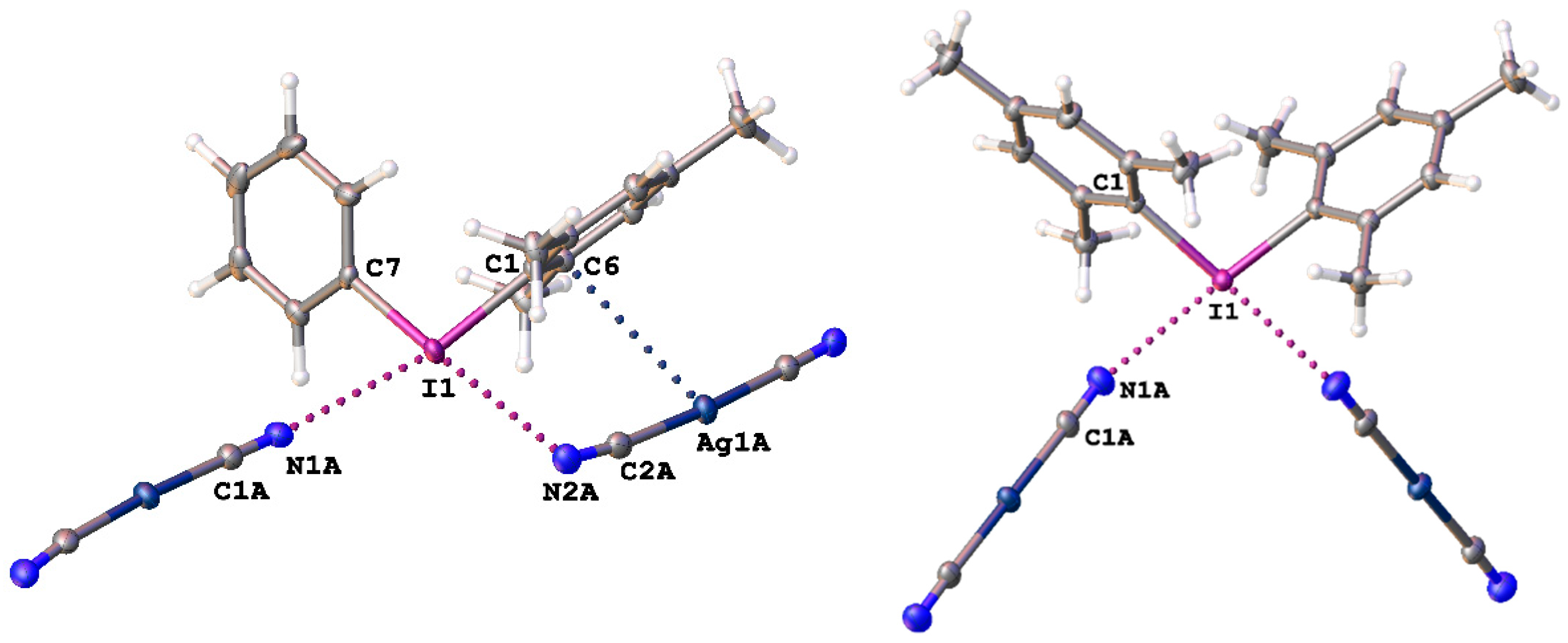
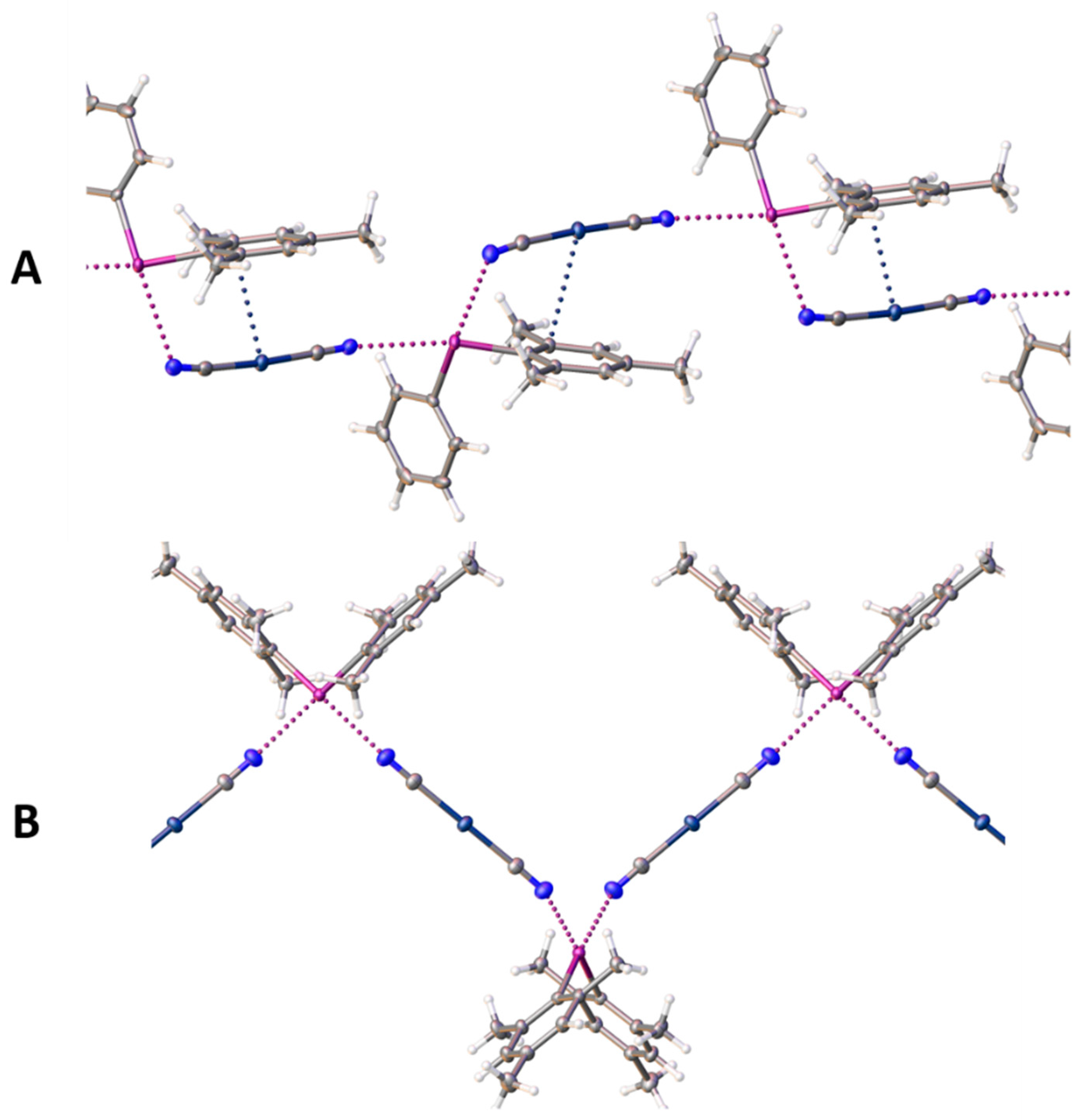
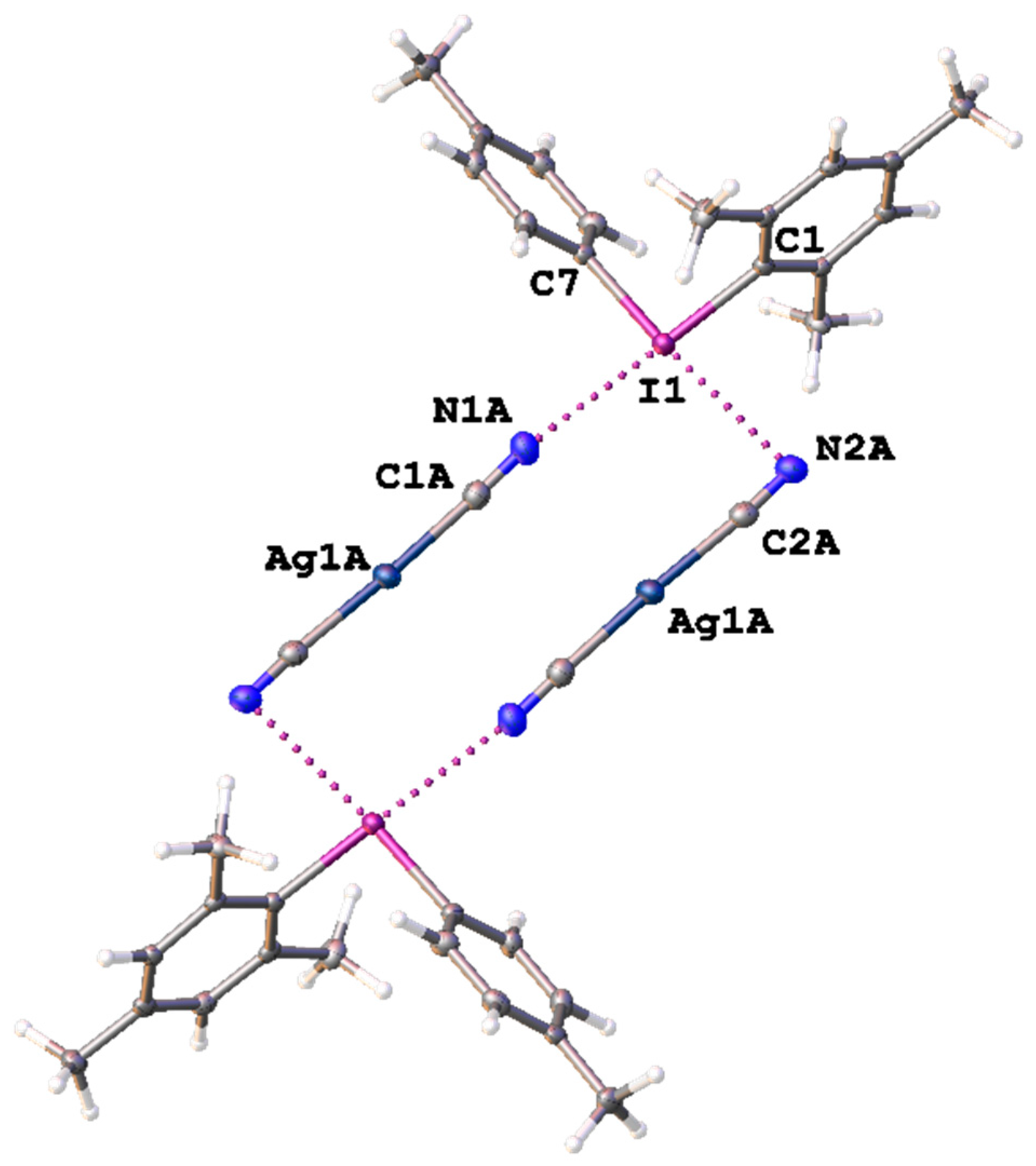



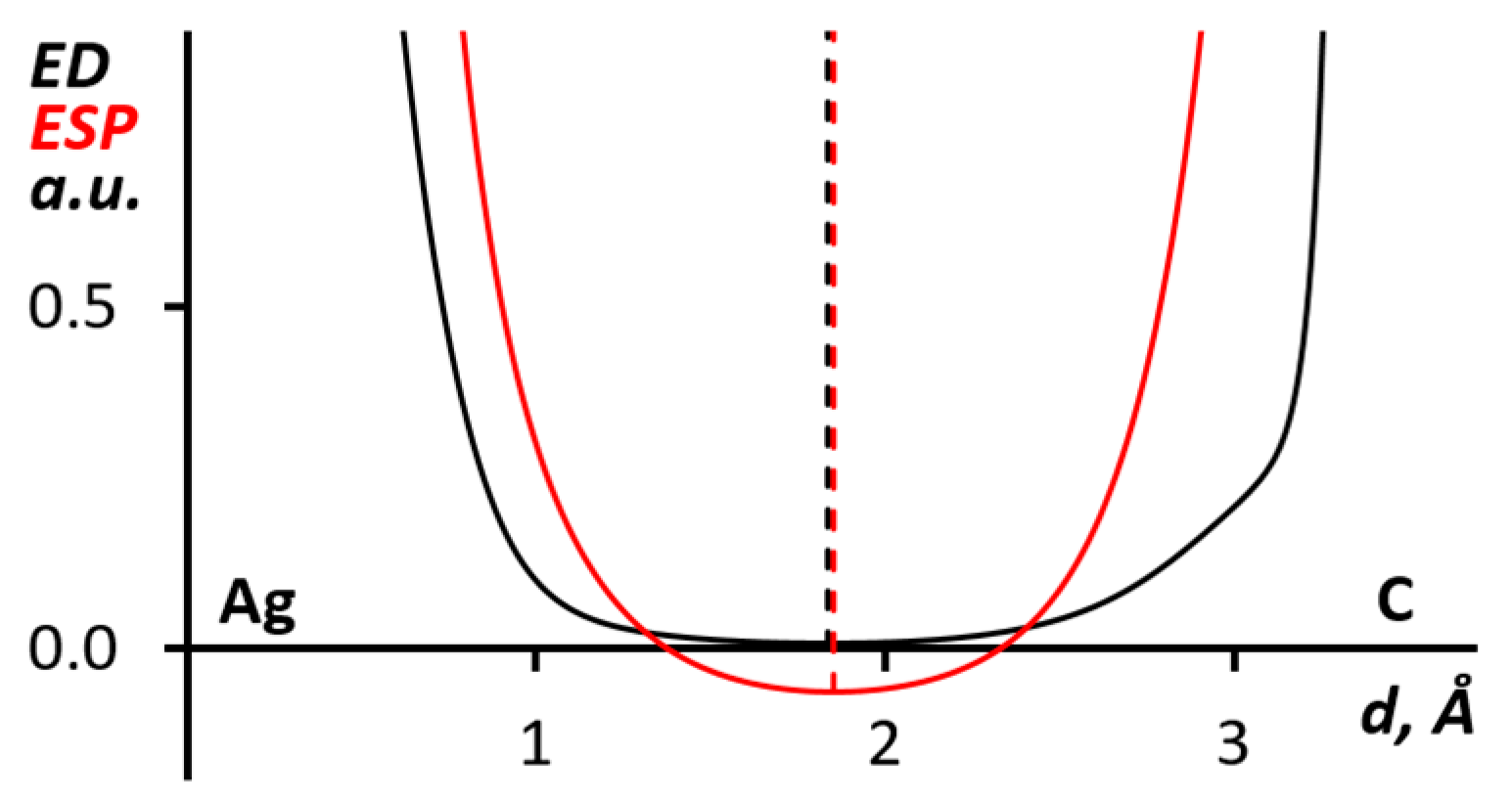
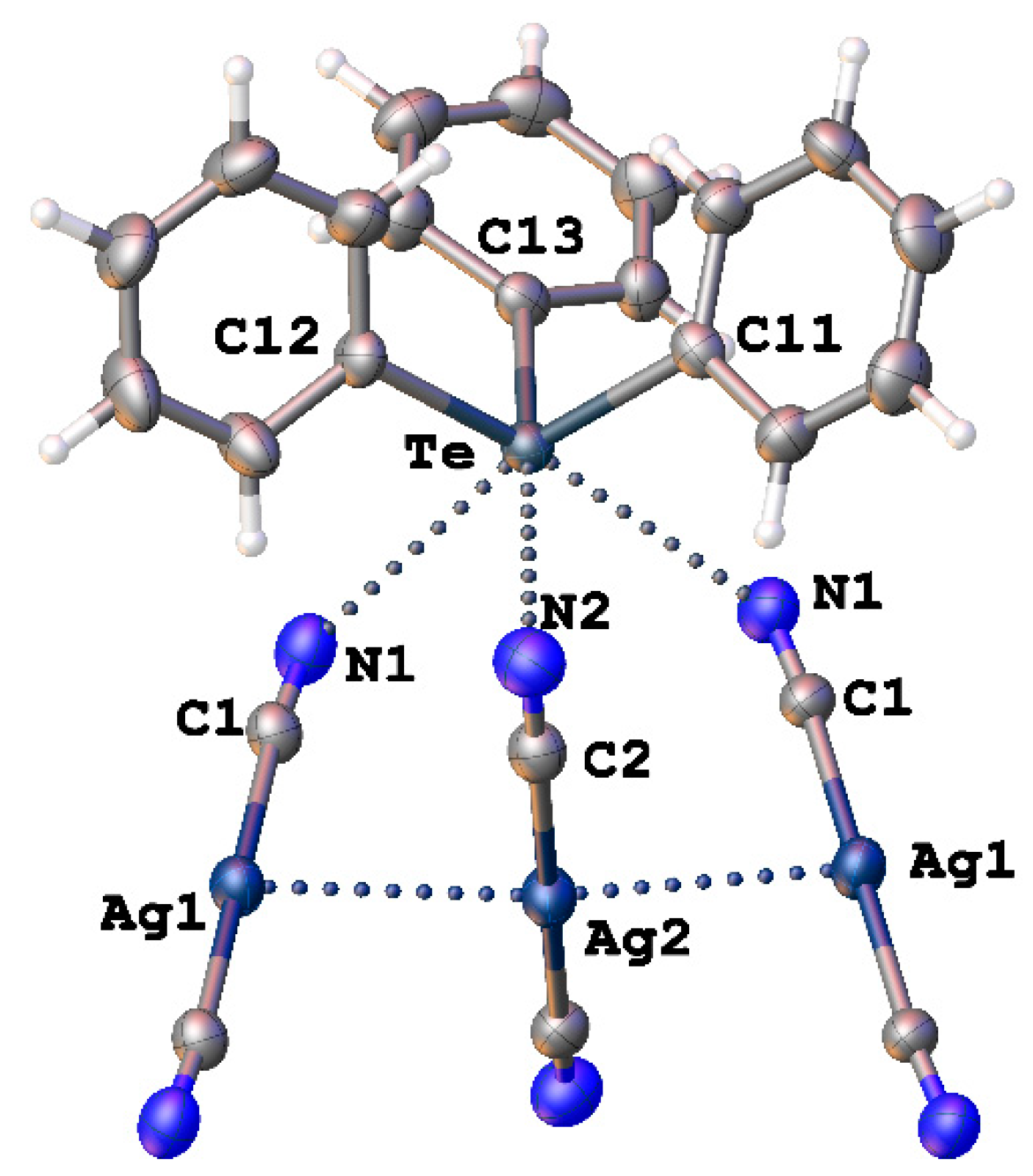

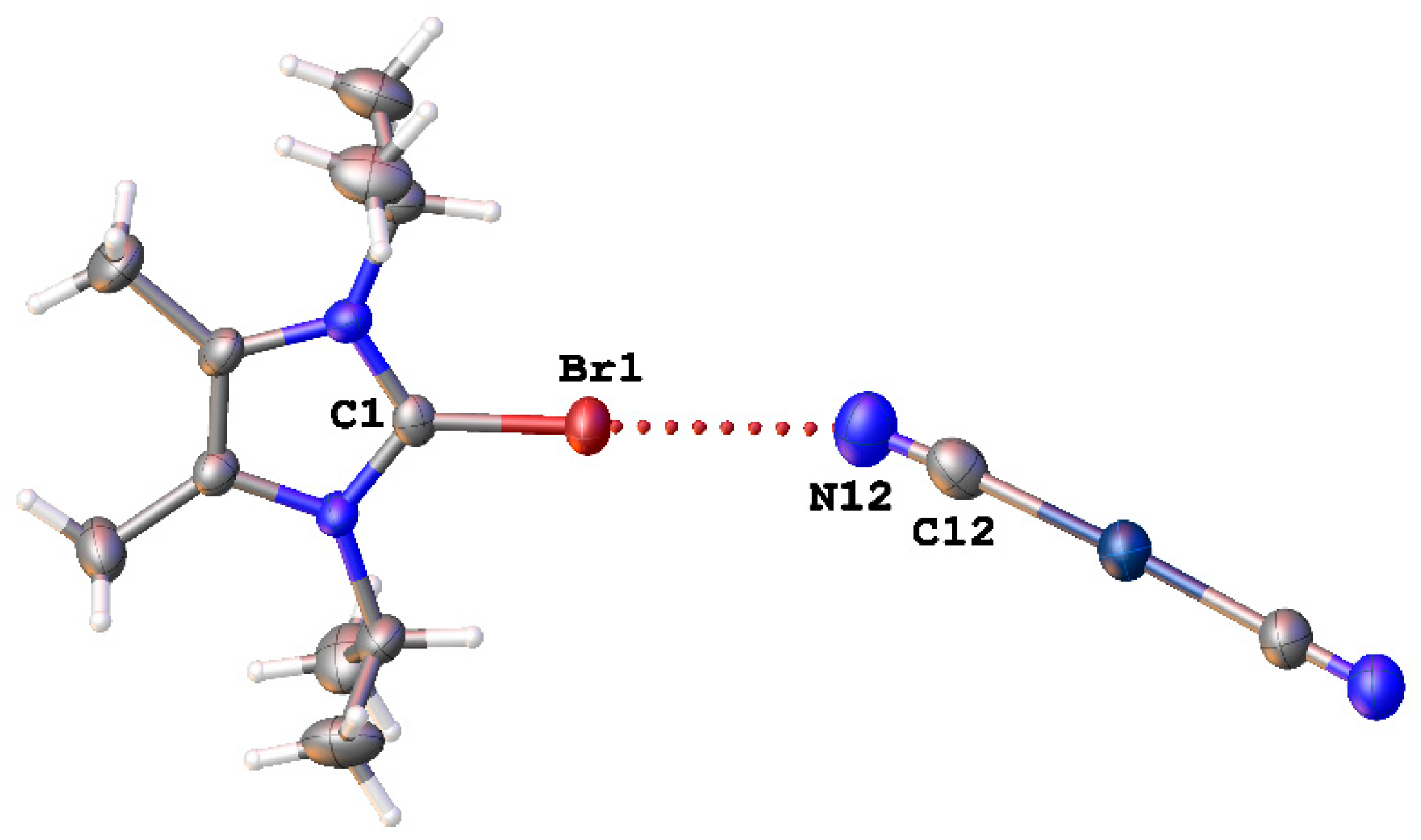
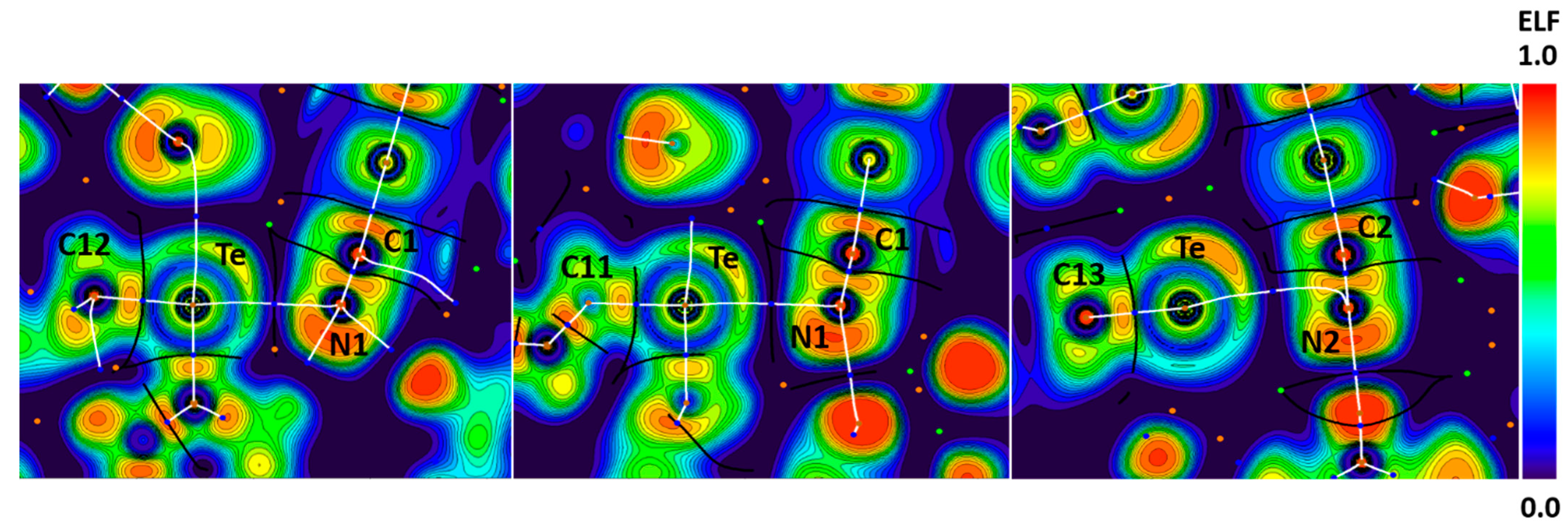
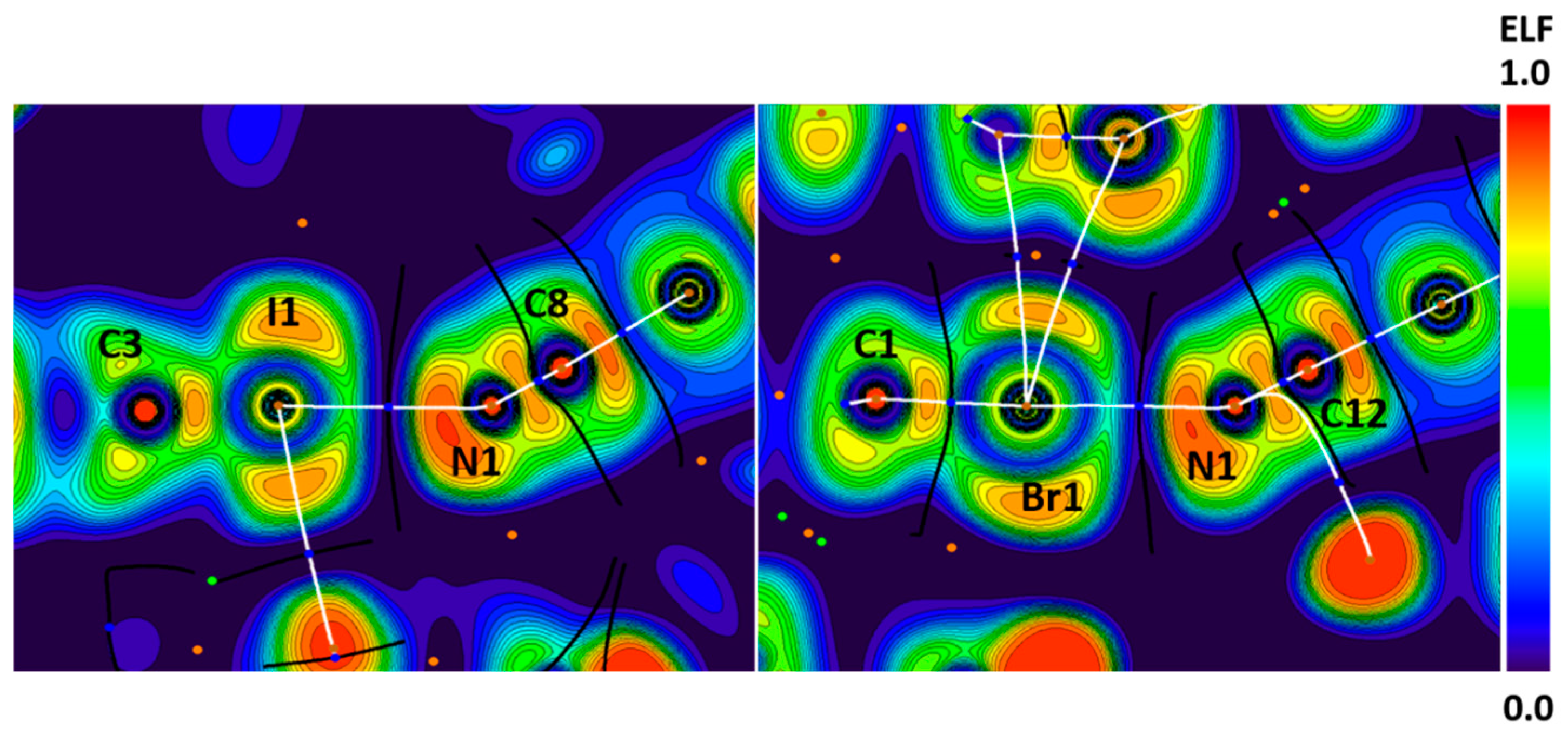
| Structure | Contact | d(I∙∙∙N), Å | ΣvdW | Nc * | ∠(C–I∙∙∙N), ° | ∠(C≡N∙∙∙I), ° |
|---|---|---|---|---|---|---|
| 1 | C1–I1∙∙∙N1A≡C1A | 2.993(3) | 3.53 | 0.85 | 168.00(8) | 154.00(15) |
| C7–I1∙∙∙N2A≡C2A | 3.033(2) | 3.53 | 0.86 | 174.19(8) | 100.85(18) | |
| 2 | C1–I1∙∙∙N1A≡C1A | 2.843(3) | 3.53 | 0.81 | 175.13(11) | 148.7(3) |
| 3 | C1–I1∙∙∙N1A≡C1A | 2.894(3) | 3.53 | 0.82 | 176.97(9) | 165.2(2) |
| C7–I1∙∙∙N2A≡C2A | 3.067(3) | 3.53 | 0.87 | 174.24(8) | 92.0(2) |
| Structure | Bond | Model | sign(λ2)ρ(r) | ∇2ρ(r) | G(r) | V(r) | Hb |
|---|---|---|---|---|---|---|---|
| 1 | C1–I1∙∙∙N1A | crystal | −0.020 | 0.059 | 0.014 | −0.013 | 0.001 |
| cluster | −0.020 | 0.059 | 0.014 | −0.013 | 0.001 | ||
| C7–I1∙∙∙N2A | crystal | −0.017 | 0.054 | 0.012 | −0.011 | 0.001 | |
| cluster | −0.017 | 0.054 | 0.012 | −0.011 | 0.001 | ||
| 2 | C1–I1∙∙∙N1A | crystal | −0.027 | 0.073 | 0.019 | −0.019 | 0.000 |
| cluster | −0.027 | 0.073 | 0.019 | −0.019 | 0.000 | ||
| 3 | C1–I1∙∙∙N1A | crystal | −0.024 | 0.069 | 0.017 | −0.017 | 0.000 |
| cluster | −0.024 | 0.069 | 0.017 | −0.017 | 0.000 | ||
| C7–I1∙∙∙N2A | crystal | −0.016 | 0.054 | 0.012 | −0.010 | 0.002 | |
| cluster | −0.016 | 0.054 | 0.012 | −0.010 | 0.002 |
| System | Bond | d(X∙∙∙Y), Å | sign(λ2)ρ(r) | ∇2ρ(r) | G(r) | V(r) | Hb |
|---|---|---|---|---|---|---|---|
| YIHDEB | C3–I1∙∙∙N1 | 2.876(5) | −0.023 | 0.070 | 0.017 | −0.017 | 0.000 |
| SADYAZ | C1–Br1∙∙∙N12 | 2.959(8) | −0.014 | 0.054 | 0.011 | −0.008 | 0.003 |
| HUHCES | C12–Te∙∙∙N1 | 3.162(5) | −0.013 | 0.042 | 0.009 | −0.008 | 0.001 |
| C11–Te∙∙∙N1 | 3.346(5) | −0.009 | 0.031 | 0.006 | −0.005 | 0.001 | |
| C13–Te∙∙∙N2 | 3.501(5) | −0.008 | 0.025 | 0.005 | −0.004 | 0.001 | |
| Ag∙∙∙Ag | 2.98470(6) | −0.026 | 0.031 | 0.013 | −0.019 | −0.006 |
Disclaimer/Publisher’s Note: The statements, opinions and data contained in all publications are solely those of the individual author(s) and contributor(s) and not of MDPI and/or the editor(s). MDPI and/or the editor(s) disclaim responsibility for any injury to people or property resulting from any ideas, methods, instructions or products referred to in the content. |
© 2025 by the authors. Licensee MDPI, Basel, Switzerland. This article is an open access article distributed under the terms and conditions of the Creative Commons Attribution (CC BY) license (https://creativecommons.org/licenses/by/4.0/).
Share and Cite
Aliyarova, I.S.; Koziakova, A.V.; Ivanov, D.M.; Soldatova, N.S.; Postnikov, P.S. Supramolecular Organization of Diaryliodonium Dicyanoargentates(I) Provided by Iodine(III)–Cyanide Halogen Bonding. Inorganics 2025, 13, 157. https://doi.org/10.3390/inorganics13050157
Aliyarova IS, Koziakova AV, Ivanov DM, Soldatova NS, Postnikov PS. Supramolecular Organization of Diaryliodonium Dicyanoargentates(I) Provided by Iodine(III)–Cyanide Halogen Bonding. Inorganics. 2025; 13(5):157. https://doi.org/10.3390/inorganics13050157
Chicago/Turabian StyleAliyarova, Irina S., Anastasiia V. Koziakova, Daniil M. Ivanov, Natalia S. Soldatova, and Pavel S. Postnikov. 2025. "Supramolecular Organization of Diaryliodonium Dicyanoargentates(I) Provided by Iodine(III)–Cyanide Halogen Bonding" Inorganics 13, no. 5: 157. https://doi.org/10.3390/inorganics13050157
APA StyleAliyarova, I. S., Koziakova, A. V., Ivanov, D. M., Soldatova, N. S., & Postnikov, P. S. (2025). Supramolecular Organization of Diaryliodonium Dicyanoargentates(I) Provided by Iodine(III)–Cyanide Halogen Bonding. Inorganics, 13(5), 157. https://doi.org/10.3390/inorganics13050157







